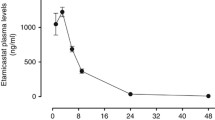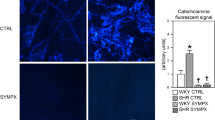Summary
To examine the antihypertensive action of the centrally acting antiadrenergic drugs moxonidine and clonidine, systolic and diastolic blood pressure as well as heart rate were monitored by radio telemetry in spontaneously hypertensive rats (SHR) with established high blood pressure. Increasing doses were administered with regular rat chow for 6–8 day periods. Moxonidine reduced (p<0.05) diastolic blood pressure at a dose of 8 mg/kg/day and systolic blood pressure at 13 mg/kg/day. Heart rate was reduced during high activity of rats corresponding to an antitachycardiac action. After withdrawal of 18 mg/kg administered for only 1 day, blood pressure returned to pretreatment values within 8 days. Clonidine reduced systolic and diastolic blood pressure at 0.3 mg/kg/day. At 0.8 and 1.3 mg/kg/day, systolic blood pressure reduction was less pronounced, although heart rate was reduced further, reaching values that were below those of untreated sleeping rats. When 1.3 mg/kg/day clonidine was discontinued, systolic as well as diastolic blood pressure increased above pretreatment values within 1 day. A rebound was also observed in heart rate, which increased by 150 beats/min. A comparable rebound in blood pressure was observed after withdrawal of 0.3 mg/kg/day. Since a blood pressure rebound occured also after withdrawal of 0.3 mg/kg/day clonidine in normotensive rats, the rebound phenomenon was independent of the presence of high blood pressure. No blood pressure rebound was observed when moxonidine (8 mg/kg/day) was administered (chow or gavage) in normotensive rats. These findings in unanesthetized undisturbed rats demonstrate distinct differences in the mode of action of moxonidine and clonidine, which can be accounted for by specific interactions of moxonidine with imidazoline I1-receptors, whereas clonidine would interact not only with I1-receptors but also with alpha2-adrenoceptors, and most probably also with the vagal activity. In view of our previous studies demonstrating a rise in blood pressure and heart rate after a hypercaloric dietary intake, the selective I1-receptor agonist moxonidine appears particularly appropriate for treating overweight hypertension associated with an enhanced sympathetic outflow of the brain. Of importance in this respect is that a moxonidine-induced reduction in sympathetic outflow was not associated with a gain in body weight but resulted in reduced caloric intake.
Similar content being viewed by others
References
Perry IJ, Whincup PH, Shaper AG. Environmental factors in the development of essential hypertension. Br Med Bull 1994;50:246–259.
Rupp H, Jacob R. Excess catecholamines and the metabolic syndrome: Should central imidazoline receptors be a therapeutic target? Med Hypotheses 1995;44:217–225.
Dhalla NS, Elimban V, Rupp H, Takeda N, Nagano M. Role of calcium in cardiac cell damage and dysfunction. In: Sperelakis N, ed. Physiology and Pathophysiology of the Heart, 3rd ed. Boston: Kluwer Academic, 1995:605–618.
Rupp H, Dhalla KS, Dhalla NS. Mechanisms of cardiac cell damage due to catecholamines: Significance of drugs regulating central sympathetic outflow. J Cardiovasc Pharmacol 1994;24(Suppl 1):S16-S24.
Hoffman BB, Lefkowitz RJ. Catecholamines and sympathomimetic drugs. In: Goodman Gilman A, Rall TW, Nies AS, Taylor P, eds. The Pharmacological Basis of Therapeutics. New York: Pergamon Press, 1990:187–220.
van Zwieten PA. The central action of antihypertensive drugs, mediated via central alpha-receptors. J Pharm Pharmacol 1973;25:89–95.
van Zwieten PA. Pharmacology of centrally acting hypotensive drugs. Br J Clin Pharmacol 1980;10:13S-20S.
Kobinger W. Central alpha-adrenergic systems as targets for hypotensive drugs. Rev Physiol Biochem Pharmacol 1978;81:40–100.
Buccafusco JJ, Lapp CA, Westbrooks KL, Ernsberger P. Role of medullary I1-imidazoline and alpha 2-adrenergic receptors in the antihypertensive responses evoked by central administration of clonidine analogs in conscious spontaneously hypertensive rats. J Pharmacol Exp Ther 1995;273: 1162–1171.
Reis DJ. The rostral ventrolateral medulla: A target of therapy for hypertension. Cardiovasc Risk Factors 1995; 5(Suppl 1):11–18.
Ernsberger P, Haxhiu MA, Graff LM, Collins LA, Dreshaj I, Grove DL, et al. A novel mechanism of action for hypertension control: Moxonidine as a selective I1-imidazoline against. Cardiovasc Drugs Ther 1994;8(Suppl 1):27–41.
Rupp H, Turcani M, Jacob R. Caloric intake and radiotelemetrically assessed high blood pressure. I. Effect of the centrally acting antihypertensive drug moxonidine. Pharm Pharmacol Lett 1993;3:103–106.
Goldberg AD, Raftery EB, Wilkinson PR. The over-shoot phenomenon on withdrawal of clonidine therapy. Postgrad Med J 1976;52(Suppl 7):128–134.
Reid JL, Dargie HJ, Davies DS, Wing LMH, Hamilton CA, Dollery CT. Clonidine withdrawal in hypertension. Changes in blood-pressure and plasma and urinary noradrenaline. Lancet 1977;1977:1171–1174.
Geyskes GG, Boer P, Dorhout Mees EJ. Clonidine with-drawal. Mechanism and frequency of rebound hypertension. Br J Clin Pharmacol 1979;7:55–62.
Weber MA. Discontinuation syndrome following cessation of treatment with clonidine and other antihypertensive agents. J Cardiovasc Pharmacol 1980;2(Suppl 1):S73-S89.
de La Coussaye JE, Eledjam JJ, Bassoul B, Bruelle P, Lefrant JY, Peray PA, et al. Receptor mechanisms for clonidine reversal of bupivacaine-induced impairment of ventricular conduction in pentobarbital-anesthetized dogs. Anesth Analg 1994;78:624–637.
Fujiwara T, Chiba S. Vascular responsiveness of rabbit common carotid, renal and femoral arteries to alpha-adrenoceptor agonists. Jpn J Pharmacol 1993;61:171–176.
Freedman RR, Moten M, Migaly P, Mayes M. Cold-induced potentiation of alpha 2-adrenergic vasoconstriction in primary Raynaud's disease. Arthritis Rheum 1993;36:685–690.
Scholtysik G, Jerie P, Picard CW. Guanfacine. In: Scriabine A, ed. Pharmacology of Antihypertensive Drugs. New York: Raven Press, 1980:79–98.
Holmes B, Brogden RN, Heel RC, Speight TM, Avery GS. Guanabenz. A review of its pharmacodynamic properties and therapeutic efficacy in hypertension. Drugs 1983;26: 212–229.
Ollivier JP, Christen MO. I1-imidazoline-receptor agonists in the treatment of hypertension: An appraisal of clinical experience. J Cardiovasc Pharmacol 1994;24(Suppl 1): S39–48.
Kraft K, Vetter H. Twenty-four-hour blood pressure profiles in patients with mild-to-moderate hypertension: Moxonidine versus captopril. J Cardiovasc Pharmacol 1994; 24(Suppl 1):S29–33.
Haxhiu MA, Dreshaj I, Erokwu B, Schäfer SG, Christen MO, Ernsberger PR. Vosodepression elicited in hypertensive rats by the selective I1-imidazoline agonist moxonidine administered into the rostral ventrolateral medulla. J Cardiovasc Pharmacol 1992;20(Suppl 4):S11-S15.
Mallard NJ, Hudson AL, Nutt DJ. Characterization and autoradiographical localization of non-adrenoceptor idazoxan binding sites in the rat brain. Br J Pharmacol 1992; 106:1019–1027.
Bjorntorp P. Treatment of obesity. Int J Obes Relat Metab Disord 1992;16(Suppl 3):S81–4.
Blundell J. Pharmacological approaches to appetite suppression. Trends Pharmacol Sci 1991;12:147–157.
Prichard BNC. Clinical experience with moxonidine. Cardiovasc Drugs Ther 1994;8(Suppl 1):49–58.
Harron DWG. Distinctive features of rilmenidine possibly related to its selectivity for imidazoline receptors. Am J Hypertens 1992;5:91S-98S.
Kaan EC, Brückner R, Frohly P, Tulp M, Schäfer SG, Ziegler D. Effects of agmatine and moxonidine on glucose metabolism: An integrated approach towards pathophysiological mechanisms in cardiovascular metabolic disorder. Cardiovasc Risk Factors 1995;5:19–27.
Author information
Authors and Affiliations
Rights and permissions
About this article
Cite this article
Rupp, H., Maisch, B. & Brilla, C.G. Drug withdrawal and rebound hypertension: Differential action of the central antihypertensive drugs moxonidine and clonidine. Cardiovasc Drug Ther 10 (Suppl 1), 251–262 (1996). https://doi.org/10.1007/BF00120495
Received:
Accepted:
Issue Date:
DOI: https://doi.org/10.1007/BF00120495




